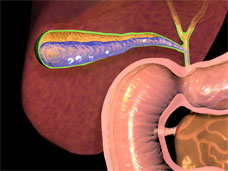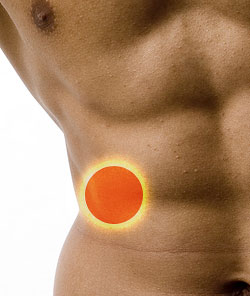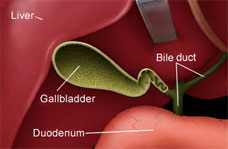|
What are gallstones?
Gallstones are hard, pebble-like deposits that form inside the
gallbladder. Gallstones may be as small as a grain of sand or as
large as a golf ball, depending on how long they have been
forming.
. Gallstones form when liquid
stored in the gallbladder hardens into pieces of stone-like
material. The liquid—called bile—helps the body digest fats. Bile
is made in the liver, then stored in the gallbladder until the
body needs it. The gallbladder contracts and pushes the bile into
a tube—called the common bile duct—that carries it to the small
intestine, where it helps with digestion.
Bile contains water, cholesterol, fats, bile salts, proteins, and
bilirubin—a waste product. Bile salts break up fat, and bilirubin
gives bile and stool a yellowish-brown color. If the liquid bile
contains too much cholesterol, bile salts, or bilirubin, it can
harden into gallstones.
The two types of gallstones are cholesterol stones and pigment
stones. Cholesterol stones are usually yellow-green and are made
primarily of hardened cholesterol. They account for about 80
percent of gallstones. Pigment stones are small, dark stones made
of bilirubin. Gallstones can be as small as a grain of sand or as
large as a golf ball. The gallbladder can develop just one large
stone, hundreds of tiny stones, or a combination of the two.
Gallstones can block the normal flow of bile if they move from the
gallbladder and lodge in any of the ducts that carry bile from the
liver to the small intestine. The ducts include the
• hepatic ducts, which carry bile out of the liver
• cystic duct, which takes bile to and from the gallbladder
• common bile duct, which takes bile from the cystic and hepatic
ducts to the small intestine
Bile trapped in these ducts can cause inflammation in the
gallbladder, the ducts, or in rare cases, the liver. Other ducts
open into the common bile duct, including the pancreatic duct,
which carries digestive enzymes out of the pancreas. Sometimes
gallstones passing through the common bile duct provoke
inflammation in the pancreas—called gallstone pancreatitis—an
extremely painful and potentially dangerous condition.
If any of the bile ducts remain blocked for a significant period
of time, severe damage or infection can occur in the gallbladder,
liver, or pancreas. Left untreated, the condition can be fatal.
Warning signs of a serious problem are fever, jaundice, and
persistent pain.
How do they occur?
The causes of gallstones vary. Some stones form when there is too
much cholesterol or bilirubin in the bile. Bile is a liquid that
helps the body digest fats. Other stones form if there are not
enough bile salts or if the gallbladder fails to empty properly.
Gallstones are a common health problem worldwide. They are more
common in women and people over the age of 40. Other risk factors
include ethnic and hereditary factors, obesity, diabetes, liver
cirrhosis, long-term intravenous nutrition, and some operations
for peptic ulcers.
Other contributory factors include obesity, excess oestrogen
hormone, cholesterol-lowering drugs, diabetes, rapid weight loss
and fasting.
What are the symptoms?
Gallstones often have no symptoms and are usually discovered by a
routine x-ray, surgery, or autopsy.
As gallstones move into the bile ducts and create blockage,
pressure increases in the gallbladder and one or more symptoms may
occur. Symptoms of blocked bile ducts are often called a
gallbladder “attack” because they occur suddenly. Gallbladder
attacks often follow fatty meals, and they may occur during the
night.
A typical attack can cause=
• steady pain in the right upper abdomen that increases rapidly
and lasts from 30 minutes to several hours
• pain in the back between the shoulder blades
• pain under the right shoulder
Notify your doctor if you think you have experienced a gallbladder
attack. Although these attacks often pass as gallstones move, your
gallbladder can become infected and rupture if a blockage remains.
People with any of the following symptoms
should see a doctor immediately:
• prolonged pain—more than 5 hours
• nausea and vomiting
• fever—even low-grade—or chills
• yellowish color of the skin or whites of the eyes
• clay-colored stools
Many people with gallstones have no symptoms; these gallstones are
called “silent stones.” They do not interfere with gallbladder,
liver, or pancreas function and do not need treatment.
How are they diagnosed?
Gallstones are easily diagnosed in symptomatic cases, but may also
show up on an X-ray or ultrasound done for some other reason. A
plain X-ray of the abdomen will show a gallstone only if it
contains calcium. Special tests for gallstones include the special
X-rays (Cholecystogram), ultrasound scanning and Endoscopic
Retrograde Cholangio-Pancreatography (ERCP). In an ERCP, a dye is
injected into the bile ducts via an endoscope and this may show
the gallstone blocking the bile duct. Magnetic resonance cholangio
- pancreatography (MRCP) is a non - invasive method but it is only
available in specialised centres. Blood tests will help to look
for infection, jaundice, obstruction and pancreatitis.
What is the treatment?
If there are no symptoms then no treatment is required in general.
In patients with gallstones and associated symptoms the treatment
choice is to remove the gallbladder (cholecystectomy). A
cholecystectomy can be performed by using an open incision or, if
possible, by a key- hole/laparoscopic method. A very small number
of patients are suitable to have their gallstones gradually
dissolved with medication but this is a slow and expensive method
and the stones often return when the treatment is stopped. In some
cases, lithotripsy can be used - this uses shock waves to shatter
gallstones to make them small enough to be treated by medication.
However, its application is limited if there are a large number of
stones present, if the stones are very large, or in the presence
of acute cholecystitis or cholangitis.
Who is
at risk for gallstones?
People at risk for gallstones include
• women—especially women who are pregnant, use hormone replacement
therapy, or take birth control pills
• people over age 60
• American Indians
• Mexican Americans
• overweight or obese men and women
• people who fast or lose a lot of weight quickly
• people with a family history of gallstones
• people with diabetes
• people who take cholesterol-lowering drugs
Do people need their gallbladder?
Fortunately, the gallbladder is an organ people can live without.
Your liver produces enough bile to digest a normal diet. Once the
gallbladder is removed, bile flows out of the liver through the
hepatic ducts into the common bile duct and directly into the
small intestine, instead of being stored in the gallbladder.
Because now the bile flows into the small intestine more often,
softer and more frequent stools can occur in about 1 percent of
people. These changes are usually temporary, but talk with your
health care provider if they persist.
What is the prevention?
There is no known way to prevent gallstones. If you have gallstone
symptoms, eating a low-fat diet and losing weight may help you
control symptoms.
What is the relationship between stones and gallbladder cancer?
Most gallbladder cancers occur in gallbladders that contain
stones. However, the risk of developing cancer because of existing
gallstones is not clearly known. Therefore, most doctors do not
advise removal of the gall bladder if the patient has no symptoms
unless there are unusual patient-related factors.
Points
to Remember
• Gallstones form when bile hardens in the gallbladder.
• Gallstones are more common among older adults; women; American
Indians; Mexican Americans; people with diabetes; those with a
family history of gallstones; people who are overweight, obese, or
undergo rapid weight loss; and those taking cholesterol-lowering
drugs.
• Gallbladder attacks often occur after eating a meal, especially
one high in fat.
• Symptoms can mimic those of other problems, including a heart
attack, so an accurate diagnosis is important.
• Gallstones can cause serious problems if they become trapped in
the bile ducts.
• Laparoscopic surgery to remove the gallbladder is the most
common treatment.
|





